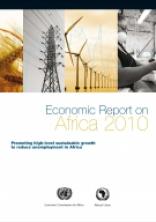Economic Report on Africa 2010

Due to the global financial crisis, the world economy contracted by 2.2 per cent in 2009, but there are signs that it has begun to stabilize. GDP growth in Africa declined from 4.9 per cent in 2008 to 1.6 per cent in 2009 and is expected to rise to 4.3 per cent in 2010. Despite the decrease in world commodity prices, primary commodity exports remain the major driver of growth in Africa.
The global economic downturn exacerbated the already high unemployment rates and vulnerable employment in Africa. Unemployment rates remained high and increasing especially among vulnerable groups in Africa even during the last decade of relatively high growth, making it difficult for the continent to reduce poverty.
Africa’s high and growing unemployment rates stem from both supply and demand sources, including rapidly growing labour supply owing to high population growth rates, increased labour participation and slow growth in labour demand as economic growth has been both insufficient and dependent on capital-intensive enclave sectors with low employment elasticity.
In the aftermath of the crisis, African countries should pursue policies that counter the effects of the recession and at the same time lay the foundation for long-term, high-level, sustainable and employment-focused growth. Besides a comprehensive development planning framework that embodies well-designed and implemented macroeconomic and sectoral strategies, this requires appropriate investment in infrastructure, human capital, improved domestic resource mobilization, factor market reforms, incentives to support private sector employment, and efforts to increase productivity.